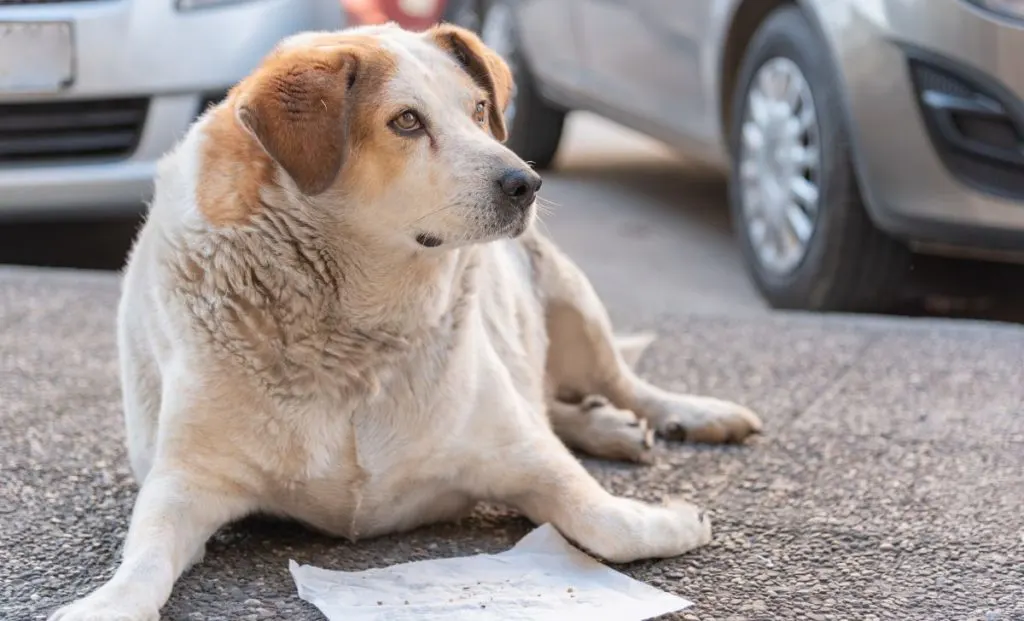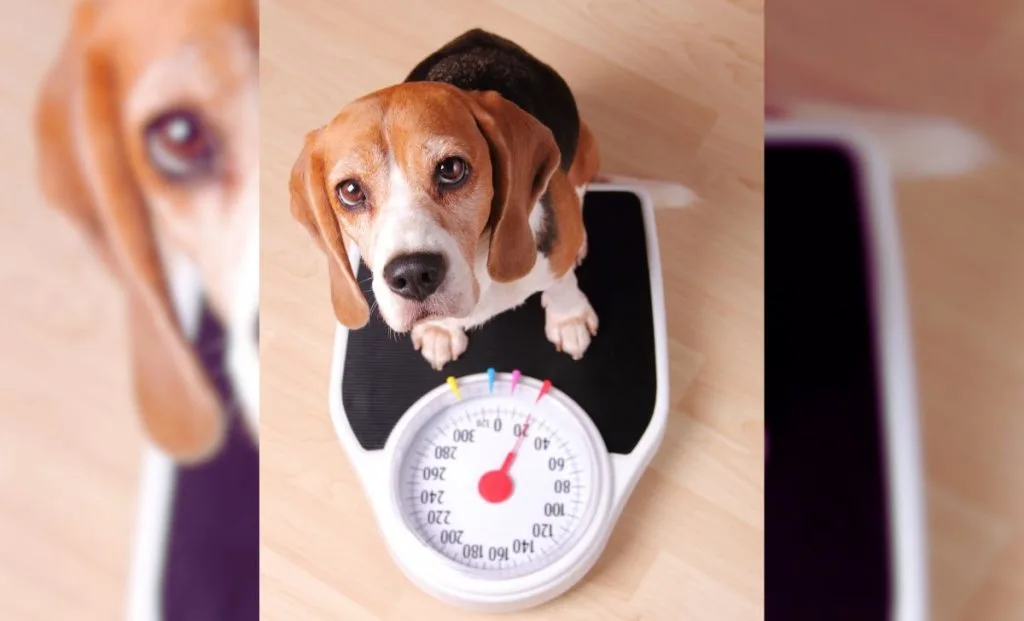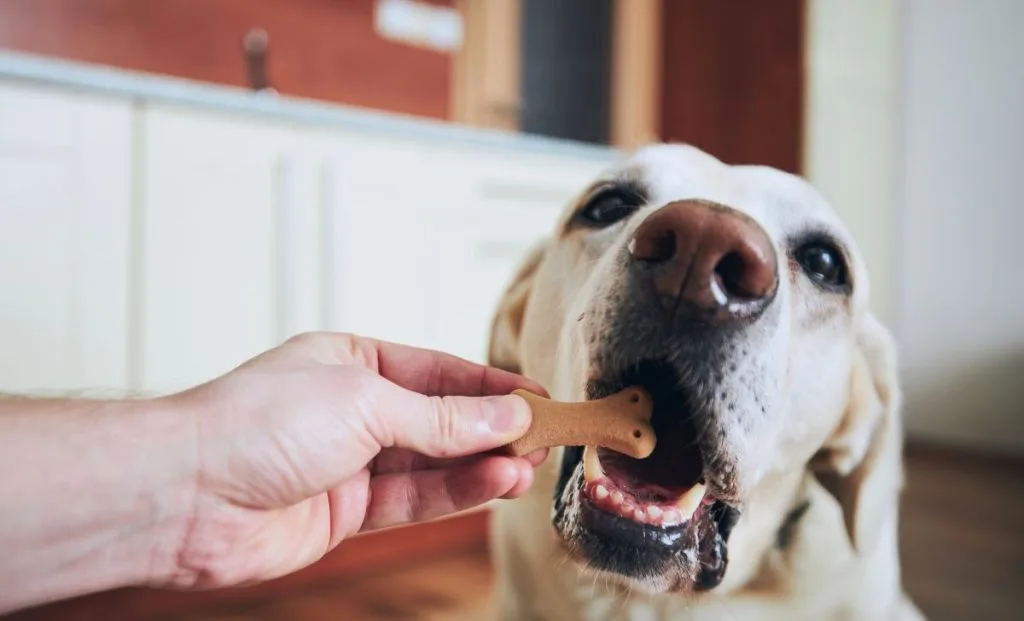Obesity is a growing epidemic, and it’s not just affecting humans.
Our beloved canine companions are increasingly falling prey to this silent yet dangerous condition.
But why is obesity in dogs becoming so prevalent? How did our furry friends become part of this concerning trend?
Well, understanding and combating canine obesity is not just about adjusting their diet or increasing their exercise.
It requires a strategic approach, delving into the root causes, recognizing the signs early, and taking proactive steps to ensure our pets lead healthy, active lives.
That is why, in this guide, we will explore the multifaceted issue of this doggie issue.
The Growing Problem Of Obesity In Dogs

Obesity in dogs has become a significant health problem in recent decades, much like it has in humans.
But, how much is this common problem actually growing? Let’s look at the scientific evidence behind numbers!
Statistics On Canine Obesity
It is increasingly acknowledged that canine obesity is a chronic low-grade inflammatory condition.
Recent studies show that about 20-40% of dogs are obese, and when you include those that are just overweight, the number can be as high as 55%.
In fact, over half of America’s dogs are currently carrying too much weight (1).
Estimates from both the UK and USA suggest that around 55% of dogs in the United States are either overweight or obese (2).
Additionally, at least one-third of dogs seen by vets are obese, and this number is growing (3).
Alright, now that we have seen the statistics of obesity in dogs, we can all agree that these studies clearly show that this is a widespread and growing problem among our furry companions.
It affects a significant portion of the canine population and brings with it serious health risks.
Causes Of Obesity In Dogs

There are many reasons behind our dog’s gaining extra body weight.
Modern lifestyles often lead to overfeeding and insufficient exercise.
Many dog owners unintentionally add to the problem by providing too many treats or table scraps without comprehending the caloric impact on their pets.
Furthermore, the convenience of dry food diets, which can be high in calories and low in filling, contributes to overeating.
Genetics
Genetics have an important factor in deciding whether your dog will become obese. You see, genes influence the way fat is stored and utilized in a dog’s body.
Some breeds of dogs are more prone to gaining weight than others. This is due to their genetic makeup.
For example, breeds like Labradors and Beagles have a higher likelihood of becoming obese dogs.
In fact, lots of published literature is on Labrador Retrievers, since they are notorious for gaining extra body weight.
Recent studies indicate that genetic factors can alter growth factors and inflammatory hormones, making weight management more challenging (4).
Scientists found specific variations in genes that are linked to obesity in Labrador Retrievers. These genetic markers can influence how a dog’s body processes and stores fat (5).
So, dogs with a genetic predisposition for obesity tend to have more fat tissues and different metabolic rates compared to lean dogs.
Environment
An environment where a dog has free choice access to food can lead to excess energy calories being consumed, resulting in extra body weight.
The type of new food introduced, often high in calories, can also be a factor.
Additionally, environments that don’t provide appropriate food for a dog’s life stage and specific diet needs can worsen the issue.
For example, food competition within multi-pet households can exacerbate this issue.
Dogs may eat more quickly or consume larger quantities if they feel they need to compete with other pets for food, leading to rapid weight gain.
This behavior can also cause bloat or even worse, gastric dilatation-volvulus (GDV), a life-threatening condition.
Lifestyle
A dog’s lifestyle, shaped largely by their owners, is another critical factor in obesity.
In recent decades, the lifestyle of pets has shifted to being more indoor-oriented, mirroring the lifestyle changes in humans.
Many dogs lead sedentary lives with inadequate exercise, especially if their owners do not have time to walk or play with them regularly.
Overfeeding is another lifestyle issue.
Many pet owners do not practice portion control, leading to dogs consuming more than they need.
The practice of feeding dogs excess energy calories through treats and table scraps is common, contributing significantly to weight gain.
A recent study by Suárez et al. demonstrated that dog owner overweight is the most significant factor contributing to obesity in dogs.
The study found that dogs with overweight owners were more than three times as likely to be obese (6).
This strong link shows that it’s important to focus on both the dog’s and the owner’s health when managing obesity to ensure effective weight control and overall well-being for both.
What Are The Clinical Signs Of Obesity In Dogs?

Clinical signs of obesity in dogs can be divided into physical, behavioral and health symptoms.
So, let’s break down each of them.
Physical Indicators
A body weight that is 15–30% over the recommended weight for the breed and size of the dog is one of the most noticeable indicators of obesity in dogs (7).
In a healthy dog, the ribs should be easily felt with a slight covering of fat.
However, in an obese dog, the ribs are often difficult to feel due to the thick layer of fat covering them.
Obese dogs often have difficulty in movement.
They may show less agility, be slower, or show a general unwillingness to engage in physical activities. This difficulty in movement is due to the extra weight that their muscles and joints have to support.
Another common physical sign of obesity is a sagging abdomen.
A noticeable droop or sag in the abdominal area occurs because the excess fat accumulates in the abdominal region, causing the skin and underlying tissues to stretch.
Additionally, fat deposits can be seen around specific areas of the body such as the base of the tail, the lower back, and the chest.
These deposits are often more visible in short-haired breeds like Dachshunds, Boxers, Pugs, and Beagles.
Behavioral Changes
Lethargy is a common behavioral change in obese dogs. They tend to be less active and may prefer lying down to moving around.
This lethargy is often a result of the increased effort required to move their heavier bodies.
Heavy dogs who are suffering from obesity may show a reduced interest in activities.
They may exhibit a decreased interest in playing, running, or engaging in activities they previously enjoyed.
This lack of interest can be attributed to the discomfort and fatigue associated with carrying extra weight.
However, obese dogs may exhibit an increased appetite, often begging for food and treats, which contributes to their weight gain (8).
Health Symptoms
One of the health symptoms of obesity in dogs is shortness of breath. Obesity can cause breathing difficulties, especially during physical activities.
Shortness of breath occurs because the excess fat puts pressure on the chest and lungs, making it harder for the dog to breathe deeply (9).
Obese dogs may also exhibit stiffness, lameness, or reluctance to move, which are signs of joint discomfort.
What Can Obesity In Dogs Lead To?

Now that we mentioned all the symptoms, we are curious what obesity in dogs can actually lead to.
The bad news is that it can lead to a number of serious health problems that can seriously shorten a dog’s life and negatively affect its quality of life.
The good news is that these can be prevented on time.
Diabetes
Canine obesity increases the risk of developing diabetes.
You see, excess body fat can cause insulin resistance, causing the cells to not respond properly to insulin.
Consequently, such change on cell level can lead to elevated blood sugar levels.
Heart Disease
Carrying extra weight puts additional strain on a dog’s heart.
Numerous cardiovascular problems, such as high blood pressure and heart disease, may result from this.
Obese dogs are, therefore, at a higher risk for developing congestive heart failure, which can drastically affect their quality of life.
Additionally, obese dogs have altered cardiac structure and function, insulin resistance, dyslipidemia, hypoadiponectinemia, and increased inflammatory markers compared to ideal weight dogs (10).
Arthritis
Extra weight puts additional pressure on a dog’s joints. This can cause wear and strain, which can eventually develop to canine arthritis.
This is especially problematic for older dogs or breeds that are already prone to joint issues such as hip and elbow dysplasia.
Arthritis causes pain and stiffness, making movement difficult and reducing a dog’s willingness to be active.
Shortened Lifespan
Obesity in dogs can significantly shorten their lifespan.
In fact, recent studies show that for every kilogram increase in body weight at 10 years of age, dogs had a 19% higher hazard of mortality (11).
The combination of diabetes, heart disease, and other obesity-related health problems can lead to an overall decrease in life expectancy.
Osteoarthritis

Obesity can exacerbate osteoarthritis, a degenerative joint disease that causes chronic pain and mobility issues.
The additional weight accelerates the deterioration of joint cartilage, leading to increased inflammation and pain.
Breathing Problems
Obesity can lead to respiratory issues, particularly in breeds with short snouts (brachycephalic breeds) like Pugs, Frenchies, Bulldogs, and Bully breeds.
Excess fat in the area around the dog’s chest and belly can restrict lung expansion. As a result, this can make it more difficult for the affected dog to breathe properly.
This is noticeable especially during physical activity.
Liver Disease
Obese dogs are at higher risk of developing liver disease, including fatty liver disease.
The liver can become overwhelmed by the excess fat, leading to inflammation and reduced liver function.
Heat Intolerance
Dogs who have excess body fat may find it more difficult to control their body temperature, which can result in heat intolerance.
This is especially common in brachycephalic breeds like French Bulldogs and Pugs.
Obese dogs are more likely to overheat and suffer from heat stroke, particularly in hot weather or after strenuous activity.
Increased Risk During Surgery
Obesity can complicate surgical procedures and anesthesia.
Obese dogs are more likely to experience difficulties before and after surgery, and having excess fat can make it more difficult for veterinarians to perform procedures.
Gastrointestinal Issues
In some obese dogs, extra body fat causes gastrointestinal problems, such as constipation and flatulence.
The extra weight can affect the digestive system, leading to discomfort and digestive disturbances.
Is Dog Obesity A Neglect?

Obesity in dogs is often considered a welfare issue and can be seen as a form of neglect. Pet owners have a responsibility to ensure their dogs maintain a healthy weight.
A study on the health-related quality of life (HRQL) in overweight and obese dogs discovered that these dogs had considerably worse scores in the energetic/enthusiastic and active/comfortable categories compared to dogs with optimum body weights (12).
Interestingly, a review of newspapers and veterinary medicine journals from 2000-2009 showed that veterinarians and animal welfare groups need to better educate people about how owners’ actions and the environment affect pets (13).
And, as mentioned throughout this article, failing to address obesity can lead to severe health problems and decreased quality of life for the dog.
How Do You Treat Obesity In Dogs?

Treating obesity in dogs requires a comprehensive approach involving proper diet, and daily exercise.
Although you may ask ”How can I reduce my dog’s weight fast?” I have to tell you that there is not a single easiest way to reduce a dog’s weight fast. It takes some time.
The good news is that with the right approach, dogs can achieve healthy looks and improved health.
So, here are various methods that can help you combat obesity in dogs.
Daily Exercise
Daily exercise is vital for weight loss in dogs. Activities like walking, playing fetch, and agility training can help burn calories and reduce extra body weight.
Is your dog in love with tennis balls? Great, you can use this to your advantage and help them build a lean body!
Regular exercise not only helps burn calories but also improves your dog’s overall health by reducing inflammatory hormones and promoting healthy, lean dogs.
Making exercise fun with play and dog training can keep your dog engaged and active.
Proper Diet
Feeding your dog the right food in the correct portions is crucial. Avoid high-calorie treats and new food that might contribute to weight gain.
Definitely avoid giving your dog chocolate, table scraps, and food containing too much fat.
Instead, focus on a specific diet recommended by your veterinarian that meets your dog’s nutritional needs without adding extra pounds.
Practicing portion control is just as important to prevent overeating.
What Foods Help Weight Loss In Dogs?
Just like in humans, certain foods are great for helping our dogs lose weight.
Think high-protein, but low-fat foods which can help maintain muscle while reducing fat.
Also, foods rich in fiber can make your dog feel full and satisfied with fewer calories.
So, here are some good choices:
- Lean meats like chicken, turkey, and fish
- Vegetables like green beans, carrots, and pumpkin
- Special weight management dog foods that provide balanced nutrition with fewer calories
What Is The Best Thing To Feed An Overweight Dog?

There is not only one thing that is best to feed an overweight dog.
And if you are wondering ”Does pumpkin help dogs lose weight?”
The good news is that yes, pumpkins can help dogs lose weight. It’s low in calories and high in fiber, which makes it a great addition to a weight-loss diet.
However, overweight dogs should not be fed pumpkin alone.
You see, the best thing to feed an obese dog is a balanced diet that meets their nutritional needs without extra calories.
As I mentioned before, look for high-quality proteins, essential vitamins, and minerals.
How Much Should I Feed My Dog To Lose Weight?
Overall, giving smaller, more frequent meals can be beneficial.
Keep track of your dog’s weight. You can do this by following specific growth charts that are made for each dog breed. For example, a simple Pug growth chart can help you monitor this breed’s healthy weight.
Along with weight monitoring, modify portions as needed for optimum weight loss.
Your veterinarian can offer recommendations depending on your dog’s weight, exercise level, and overall health.
Is Wet Or Dry Food Better For Overweight Dogs?
Both wet and dry food can be good for overweight dogs, but each has its benefits.
Dry food is convenient and often has fewer calories per serving, making portion control easier.
Wet food usually has higher moisture content, which can help your dog feel full with less food.
The key is choosing a weight management formula and following your veterinarian’s recommendations for the best results.
Obesity in dogs is about more than just losing weight. It is also about increasing their general quality of life.
Different dogs have different needs and require different approaches.
So keep that in mind, and best of luck!
References
1. Wambaugh, S. (2013). Combating Canine Obesity in the United States. . https://doi.org/10.2139/SSRN.2338905.
2. Boland, Z. (2014). Companion animal obesity: a silent epidemic?. Companion Animal, 19, 240-244. https://doi.org/10.12968/COAN.2014.19.5.240.
3. Zoran, D. (2010). Obesity in dogs and cats: a metabolic and endocrine disorder.. The Veterinary clinics of North America. Small animal practice, 40 2, 221-39 . https://doi.org/10.1016/j.cvsm.2009.10.009.
4. Grant, R., Boler, B., Ridge, T., Graves, T., & Swanson, K. (2011). Alterations in STAT signaling gene expression during obesity development in dogs. The FASEB Journal, 25. https://doi.org/10.1096/fasebj.25.1_supplement.778.4.
5. Mankowska, M., Stachowiak, M., Graczyk, A., Ciążyńska, P., Gogulski, M., Niżański, W., & Świtoński, M. (2016). Sequence analysis of three canine adipokine genes revealed an association between TNF polymorphisms and obesity in Labrador dogs.. Animal genetics, 47 2, 245-9 . https://doi.org/10.1111/age.12390.
6. Suarez L, Bautista-Castaño I, Peña Romera C, Montoya-Alonso JA, Corbera JA. Is Dog Owner Obesity a Risk Factor for Canine Obesity? A “One-Health” Study on Human-Animal Interaction in a Region with a High Prevalence of Obesity. Vet Sci. 2022 May 22;9(5):243. doi: 10.3390/vetsci9050243. PMID: 35622771; PMCID: PMC9147579.
7. Gossellin, J., Wren, J., & Sunderland, S. (2007). Canine obesity: an overview.. Journal of veterinary pharmacology and therapeutics, 30 Suppl 1, 1-10 .
8. Ramsey, I., & German, A. (2008). Update on the management of canine obesity. Companion Animal, 13, 33-37. https://doi.org/10.1111/J.2044-3862.2008.TB00524.X.
9. Stogdale, L., & Moore, D. (1980). Obesity in a dog, with secondary hormonal imbalance.. Journal of the South African Veterinary Association, 51 1, 41-5 .
10. Tropf, M., Nelson, O., Lee, P., & Weng, H. (2017). Cardiac and Metabolic Variables in Obese Dogs. Journal of Veterinary Internal Medicine, 31, 1000 – 1007. https://doi.org/10.1111/jvim.14775.
11. Penell, J., Morgan, D., Watson, P., Carmichael, S., & Adams, V. (2019). Body weight at 10 years of age and change in body composition between 8 and 10 years of age were related to survival in a longitudinal study of 39 Labrador retriever dogs. Acta Veterinaria Scandinavica, 61. https://doi.org/10.1186/s13028-019-0477-x.
12. Yam, P., Butowski, C., Chitty, J., Naughton, G., Wiseman-Orr, M., Parkin, T., & Reid, J. (2016). Impact of canine overweight and obesity on health-related quality of life.. Preventive veterinary medicine, 127, 64-9 . https://doi.org/10.1016/j.prevetmed.2016.03.013.
13. Degeling, C., Rock, M., & Teows, L. (2011). Portrayals of Canine Obesity in English-Language Newspapers and in Leading Veterinary Journals, 2000–2009: Implications for Animal Welfare Organizations and Veterinarians as Public Educators. Journal of Applied Animal Welfare Science, 14, 286 – 303. https://doi.org/10.1080/10888705.2011.600160.

Meet Iram, a devoted veterinarian, passionate dog lover, and current Ph.D. candidate at Utrecht University in the Netherlands. Seamlessly blending her roles as a vet and content writer, Iram channels her love for dogs into heartfelt narratives.
Since childhood, Iram nurtured a dream of becoming a vet, a passion that runs deep in her family. Having now fulfilled that dream, she’s eager to share her acquired knowledge. In her writing, Iram not only explores the emotional bond between humans and their canine friends but also integrates her veterinary expertise, offering readers a holistic understanding of their beloved pets.
